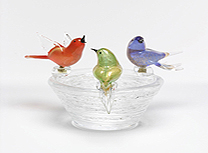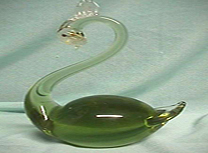
Glass art is the use of glass as an artistic medium Specific approaches include stained glass, working glass in a torch flame (lampworking), glass beadmaking, glass casting, glass fusing, and, most notably, glass blowing. As a decorative and functional medium, glass was extensively developed in Egypt and Assyria, brought to the fore by the Romans (who developed glassblowing), and includes among its greatest triumphs European cathedral stained glass windows. Great ateliers like Tiffany, Lalique, Daum, Gallé, the Corning schools in upper New York state, and Steuben Glass Works took glass art to the highest levels. Glass from Murano (also known as Venetian glass) is the result of hundreds of years of refinement and invention. While there are now more hotshops and glass artists working in Seattle (USA), Murano is still held as the birthplace of modern glass art. The glass objects created are intended to make a sculptural or decorative statement. On the market, their prices may range from a few hundred to tens of thousands of dollars (US). Prior to the early 1960s, the term "glass art" referred to glass made for decorative use, usually by teams of factory workers, taking glass from furnaces with a thousand or more pounds of glass. This form of glass art, of which Tiffany and Steuben in the U.S.A., Gallé in France and Hoya Crystal in Japan, Royal Leerdam Crystal in The Netherlands and Kosta Boda in Sweden are perhaps the best known, grew out of the factory system in which all glass objects were hand or mold blown by teams of 4 or more men. The turn of the 19th Century was the height of the old art glass movement while the factory glass blowers were being replaced by mechanical bottle blowing and continuous window glass.


